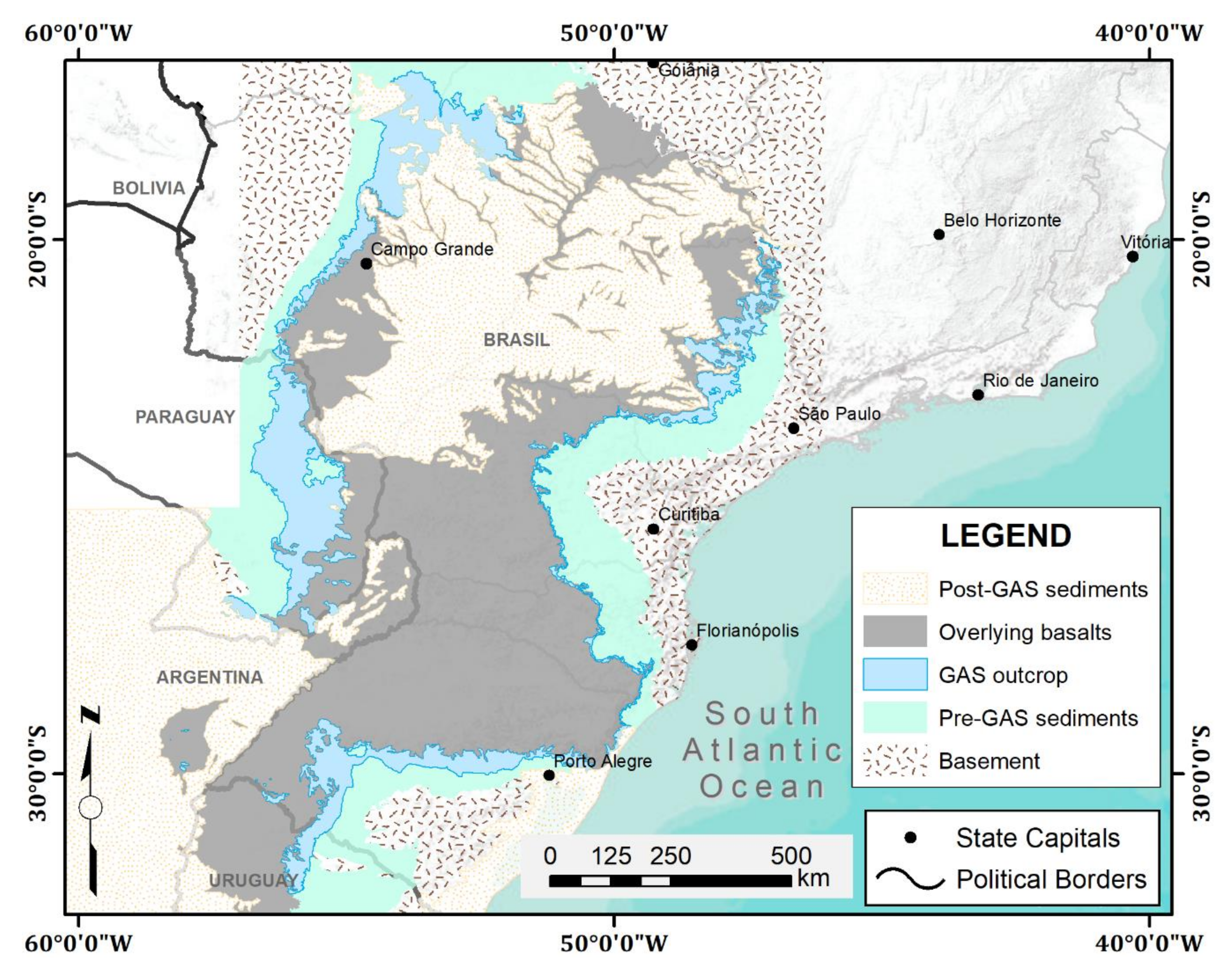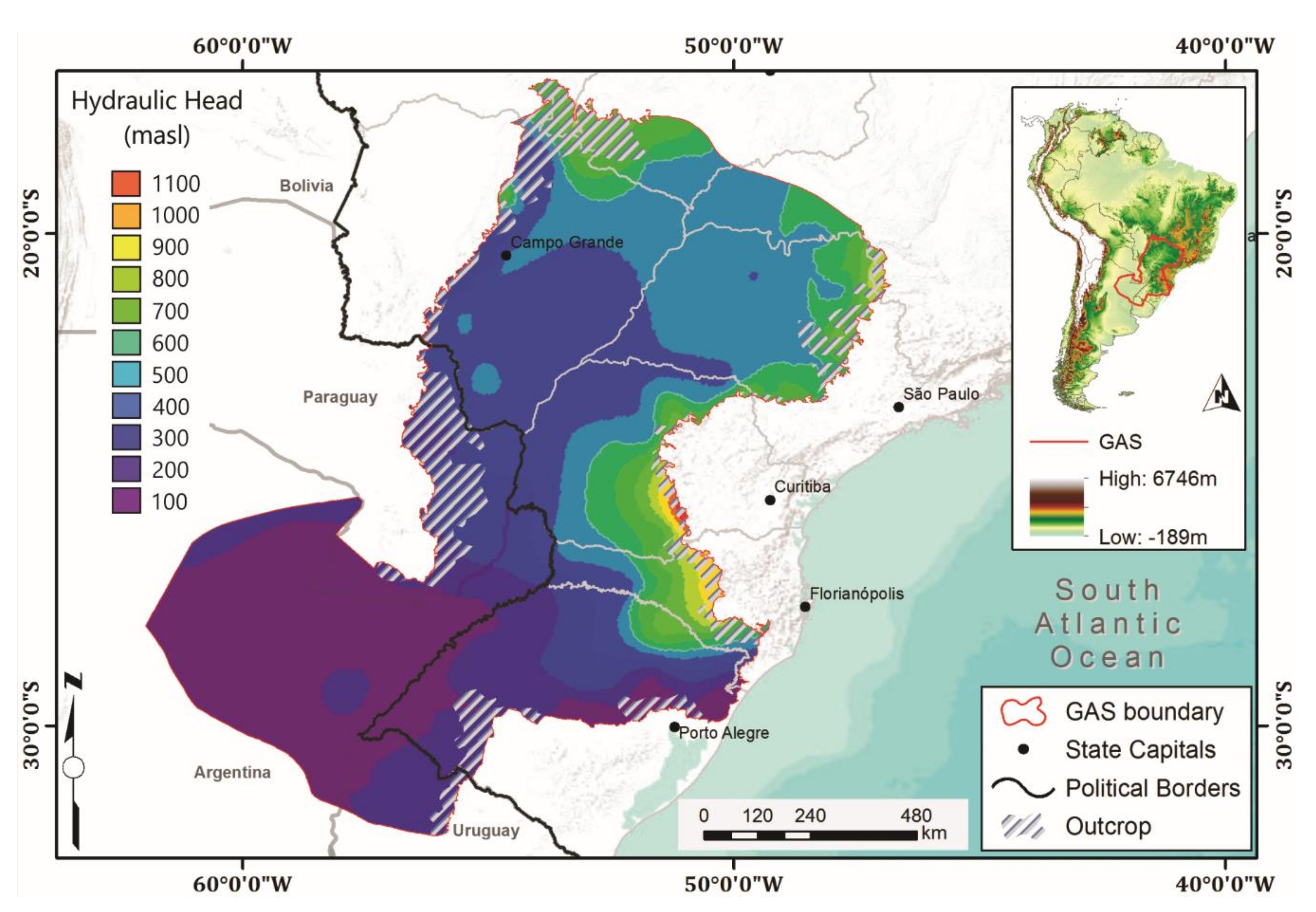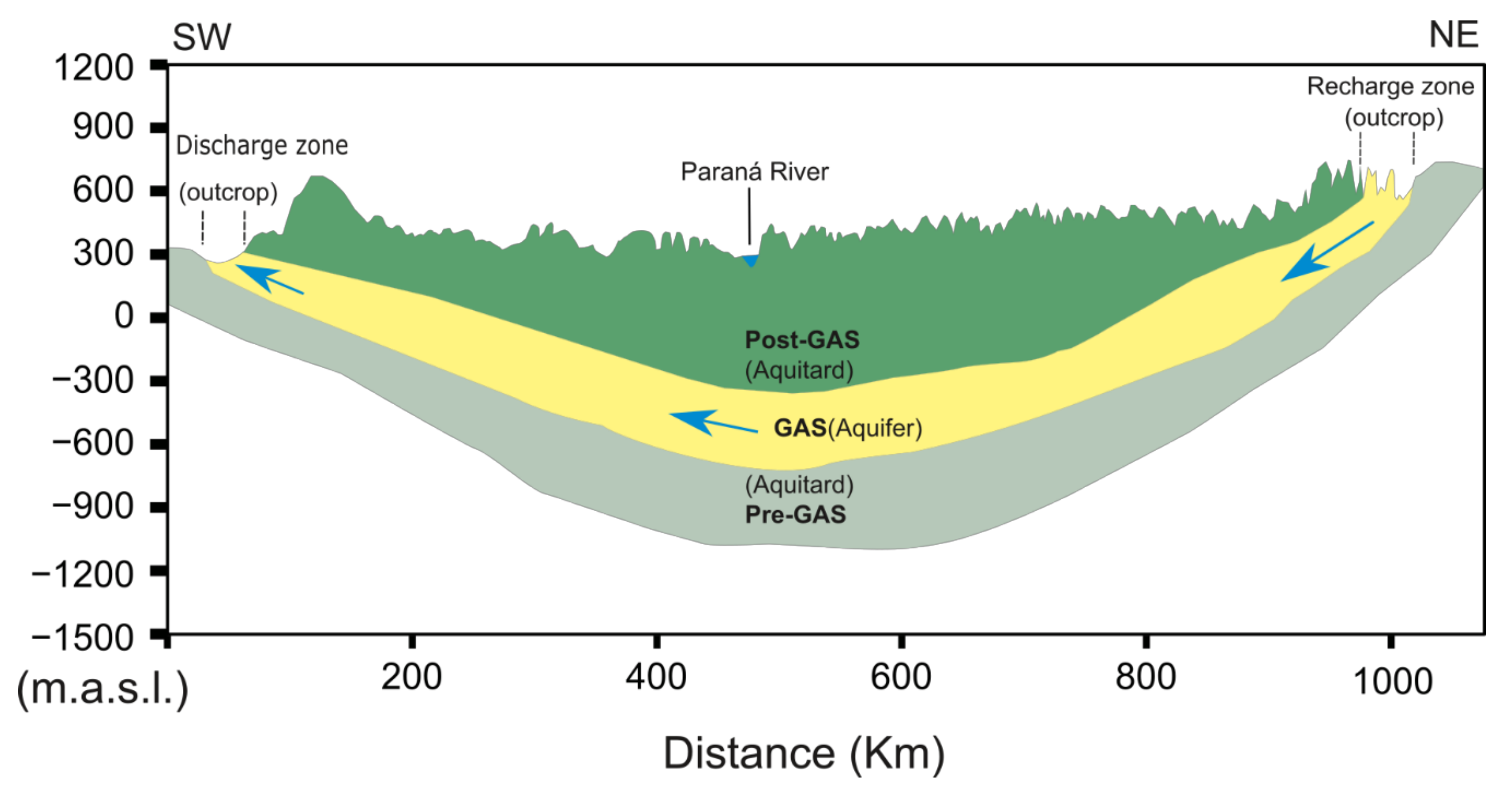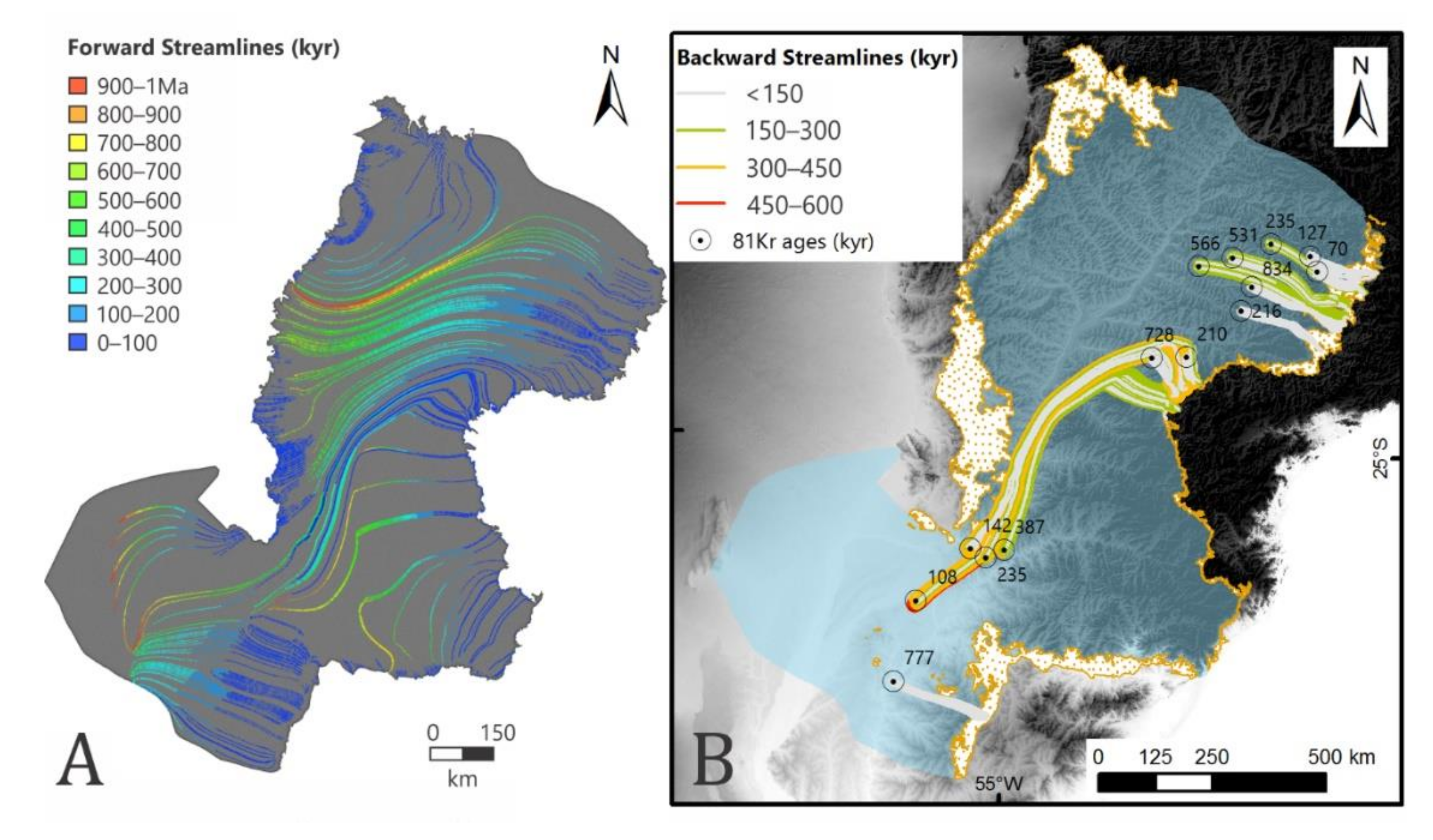Regional Groundwater Modeling of the Guarani Aquifer System
Abstract
1. Introduction
2. Conceptual Model
3. Numerical Model
4. Results and Discussion
4.1. Piezometric Levels
4.2. Hydraulic Conductivity
4.3. Water Budget and Recharge Estimates
4.4. Groundwater Age Analysis
4.5. Model Discussion
5. Conclusions
Author Contributions
Funding
Acknowledgments
Conflicts of Interest
References
- Kemper, K.E.; Mestre, E.; Amore, L. Management of the Guarani Aquifer System. Water Int. 2003, 28, 185–200. [Google Scholar] [CrossRef]
- Sindico, F.; Hirata, R.; Manganelli, A. The Guarani Aquifer System: From a Beacon of hope to a question mark in the governance of transboundary aquifers. J. Hydrol. Reg. Stud. 2018, 20, 49–59. [Google Scholar] [CrossRef]
- Gómez, A.A.; Rodríguez, L.B.; Vives, L.S. The Guarani Aquifer System: Estimation of recharge along the Uruguay–Brazil border. Hydrogeol. J. 2010, 18, 1667–1684. [Google Scholar] [CrossRef]
- Machado, A.R.; Wendland, E.; Krause, P. Hydrologic Simulation for Water Balance Improvement in an Outcrop Area of the Guarani Aquifer System. Environ. Process. 2016, 3, 19–38. [Google Scholar] [CrossRef]
- Rabelo, J.L.; Wendland, E. Assessment of groundwater recharge and water fluxes of the Guarani Aquifer System, Brazil. Hydrogeol. J. 2009, 17, 1733–1748. [Google Scholar] [CrossRef]
- Rebouças, A.C. Recursos Hídricos Subterrâneos da Bacia do Paraná—Análise de Pré-Viabilidade; Universidade de São Paulo: São Paulo, Brazil, 1976. [Google Scholar]
- Rodríguez, L.; Vives, L.; Gomez, A. Conceptual and numerical modeling approach of the Guarani Aquifer System. Hydrol. Earth Syst. Sci. 2013, 17, 295–314. [Google Scholar] [CrossRef]
- Wendland, E.; Gomes, L.H.; Troeger, U. Recharge contribution to the Guarani Aquifer System estimated from the water balance method in a representative watershed. An. Acad. Bras. Cienc. 2015, 87, 595–609. [Google Scholar] [CrossRef]
- Organização dos Estados Americanos (OEA). Aquífero Guarani: Programa Estratégico de Ação = Acuífero Guaraní: Programa Estatégico de Acción—Edição Bilíngüe; Organização dos Estados Americanos (OEA): Washington, DC, USA, 2009; ISBN 978-85-98276-07-6. [Google Scholar]
- Foster, S.; Hirata, R.; Vidla, A.; Schmidt, G.; Garduño, H. Sustainable Groundwater Groundwater Management: Management Concepts Lessons and Tools from Practice The Guarani Aquifer Initiative—Towards Realistic Groundwater Management in a Transboundary Context. GW Mate World Bank 2009, 1–28. [Google Scholar]
- Villar, P.C.; Ribeiro, W.C. The Agreement on the Guarani Aquifer: A new paradigm for transboundary groundwater management? Water Int. 2011, 36, 646–660. [Google Scholar] [CrossRef]
- Amore, L. The Guarani Aquifer: From Knowledge to Water Management. Int. J. Water Resour. Dev. 2011, 27, 463–476. [Google Scholar] [CrossRef]
- Rayale, K.; Little, K.; Crawford, M.; Swatuk, L. Transboundary groundwater governance and management: The case of the Guarani Aquifer–Brazil, Argentina, Paraguay, Uruguay. In Water, Climate Change and the Boomerang Effect; Swatuk, L.A., Wirkus, L., Eds.; Routledge: London, UK, 2018; pp. 36–49. ISBN 9781315149806. [Google Scholar]
- Machado, J.L.F. Compartimentação Espacial e Arcabouço Hidroestratigráfico do SISTEMA Aqüífero Guarani no Rio Grande do Sul; UNISINOS: São Leopoldo, Brazil, 2005. [Google Scholar]
- Soares, A.P.; Soares, P.C.; Bettú, D.F.; Holz, M. Compartimentação estrutural da Bacia do Paraná: A questão dos lineamentos e sua influência na distribuição do Sistema Aquífero Guarani. Geociências UNESP São Paulo 2007, 26, 297–311. [Google Scholar]
- Gastmans, D.; Mira, A.; Kirchheim, R.; Vives, L.; Rodríguez, L.; Veroslavsky, G. Hypothesis of Groundwater Flow through Geological Structures in Guarani Aquifer System (GAS) using Chemical and Isotopic Data. Procedia Earth Planet. Sci. 2017, 17, 136–139. [Google Scholar] [CrossRef]
- Mira, A.; Vives, L.; Rodríguez, L.; Veroslavsky, G. Modelo hidrogeológico conceptual y numérico del Sistema Acuífero Guaraní (Argentina, Brasil, Paraguay y Uruguay). Geogaceta 2018, 64, 67–70. [Google Scholar]
- Sapriza, G.; Gastmans, D.; De los Santos, J.; Flaquer, A.; Chang, H.K.; Guimaraens, M.; De Paula e Silva, F. Modelo Numérico De Fluxo Do Sistema Aquífero Guarani (Sag) Em Área De Afloramentos—Artigas (Uy)/Quarai (BR). Águas Subterrâneas 2011, 25, 29–42. [Google Scholar] [CrossRef]
- Vives, L.; Campos, H.; Candela, L.; Guarracino, L. Modelación del acuífero Guaraní. Bol. Geol. Min. 2001, 112, 51–64. [Google Scholar]
- Diersch, H.-J.G. FEFLOW: Finite ElementModeling of Flow, Mass and Heat Transport in Porous and Fractured Media; Springer: Berlin/Heidelberg, Germany, 2014; ISBN 978-3-642-38738-8. [Google Scholar]
- Gastmans, D.; Veroslavsky, G.; Kiang Chang, H.; Caetano-Chang, M.R.; Nogueira Pressinotti, M.M. Hydrogeological conceptual model for Guarani Aquifer System: A tool for management. Boletín Geológico Min. 2012, 123, 249–265. [Google Scholar]
- Schulze-Makuch, D.; Carlson, D.A.; Cherkauer, D.S.; Malik, P. Scale Dependency of Hydraulic Conductivity in Heterogeneous Media. Ground Water 1999, 37, 904–919. [Google Scholar] [CrossRef]
- Clauser, C. Permeability of crystalline rocks. Eos Trans. Am. Geophys. Union 1992, 73, 233. [Google Scholar] [CrossRef]
- Araújo, L.M.; França, A.B.; Potter, P.E. Hydrogeology of the Mercosul aquifer system in the Paraná and Chaco-Paraná Basins, South America, and comparison with the Navajo-Nugget aquifer system, USA. Hydrogeol. J. 1999, 7, 317–336. [Google Scholar] [CrossRef]
- Wahnfried, I.; Fernandes, A.; Hirata, R.; Maldaner, C.; Varnier, C.; Ferreira, L.; Iritani, M.; Pressinotti, M. Anisotropia e confinamento hidráulico do Sistema Aquífero Guarani em Ribeirão Preto (SP, Brasil). Geol. USP Série Científica 2018, 18, 75–88. [Google Scholar] [CrossRef]
- Wendland, E.; Gomes, L.E.; Porto, R.M. Use of convolution and geotechnical rock properties to analyze free flowing discharge test. An. Acad. Bras. Cienc. 2014, 86, 117–126. [Google Scholar] [CrossRef][Green Version]
- Engelbrecht, B.Z.; Teramoto, E.H.; Gonçalves, R.D.; Chang, H.K. Estimativas de condutividade hidráulica a partir de perfilagens geofísicas no Sistema Aquífero Guarani. Holos Environ. 2020, 20, 117. [Google Scholar] [CrossRef][Green Version]
- Aggarwal, P.K.; Matsumoto, T.; Sturchio, N.C.; Chang, H.K.; Gastmans, D.; Araguas-Araguas, L.J.; Jiang, W.; Lu, Z.-T.; Mueller, P.; Yokochi, R.; et al. Continental degassing of 4He by surficial discharge of deep groundwater. Nat. Geosci. 2014, 8, 35–39. [Google Scholar] [CrossRef]
- Gastmans, D.; Chang, H.K.; Hutcheon, I. Groundwater geochemical evolution in the northern portion of the Guarani Aquifer System (Brazil) and its relationship to diagenetic features. Appl. Geochem. 2010, 25, 16–33. [Google Scholar] [CrossRef]
- França, A.B.; Araújo, L.M.; Maynard, J.B.; Potter, P.E. Secondary porosity formed by deep meteoric leaching: Botucatu eolianite, southern South America. Am. Assoc. Pet. Geol. Bull. 2003, 87, 1073–1082. [Google Scholar] [CrossRef]
- Sracek, O.; Hirata, R. Geochemical and stable isotopic evolution of the Guarani Aquifer System in the state of São Paulo, Brazil. Hydrogeol. J. 2002, 10, 643–655. [Google Scholar] [CrossRef]
- Gonçalves, R.D.; Chang, H.K. Modelo Hidrogeológico do Sistema Aquífero Urucuia na Bacia do Rio Grande (BA). Geociências 2017, 36, 205–220. [Google Scholar] [CrossRef]
- Chang, H.K. Proteção Ambiental e Gerenciamento Sustentável Integrado do Aquífero Guarani—Tema 3. UNESP/IGCE: São Paulo, Brazil, 2001. Available online: http://www.ana.gov.br/guarani/gestao/gest_%20cbasico.htm (accessed on 1 August 2020).
- Gilboa, Y.; Mero, F.; Mariano, I.B. The Botucatu aquifer of South America, model of an untapped continental aquifer. J. Hydrol. 1976, 29, 165–179. [Google Scholar] [CrossRef]
- Healy, R.W.; Cook, P.G. Using groundwater levels to estimate recharge. Hydrogeol. J. 2002, 10, 91–109. [Google Scholar] [CrossRef]
- Wendland, E.; Barreto, C.; Gomes, L.H. Water balance in the Guarani Aquifer outcrop zone based on hydrogeologic monitoring. J. Hydrol. 2007, 342, 261–269. [Google Scholar] [CrossRef]
- Gonçalves, R.D.; Teramoto, E.H.; Engelbrecht, B.Z.; Soto, M.A.A.; Chang, H.K.; Genuchten, M.T. Quasi-Saturated Layer: Implications for Estimating Recharge and Groundwater Modeling. Groundwater 2019, 58, 235–247. [Google Scholar] [CrossRef] [PubMed]
- Teramoto, E.H.; Gonçalves, R.D.; Chang, H.K. Hydrochemistry of the Guarani Aquifer modulated by mixing with underlying and overlying units. J. Hydrol. Reg. Stud. 2020, Submitted. [Google Scholar]
- Elliot, T.; Bonotto, D.M. Hydrogeochemical and isotopic indicators of vulnerability and sustainability in the GAS aquifer, São Paulo State, Brazil. J. Hydrol. Reg. Stud. 2017, 14, 130–149. [Google Scholar] [CrossRef][Green Version]
- McCallum, J.L.; Cook, P.G.; Simmons, C.T. Limitations of the Use of Environmental Tracers to Infer Groundwater Age. Groundwater 2015, 53, 56–70. [Google Scholar] [CrossRef] [PubMed]
- Larocque, M.; Cook, P.G.; Haaken, K.; Simmons, C.T. Estimating Flow Using Tracers and Hydraulics in Synthetic Heterogeneous Aquifers. Ground Water 2009, 47, 786–796. [Google Scholar] [CrossRef]
- McMahon, P.B.; Plummer, L.N.; Bhlke, J.K.; Shapiro, S.D.; Hinkle, S.R. A comparison of recharge rates in aquifers of the United States based on groundwater-age data. Hydrogeol. J. 2011, 19, 779–800. [Google Scholar] [CrossRef]
- Solomon, D.K.; Sudicky, E.A. Tritium and Helium 3 Isotope Ratios for Direct Estimation of Spatial Variations in Groundwater Recharge. Water Resour. Res. 1991, 27, 2309–2319. [Google Scholar] [CrossRef]
- Navarro, J.; Teramoto, E.H.; Engelbrecht, B.Z.; Chang, H.K. Assessing hydrofacies and hydraulic properties of basaltic aquifers derived from geophysical logging. Braz. J. Geology 2020, 50, 234–245. [Google Scholar] [CrossRef]
- Zakharova, N.V.; Goldberg, D.S.; Sullivan, E.C.; Herron, M.M.; Grau, J.A. Petrophysical and geochemical properties of Columbia River flood basalt: Implications for carbon sequestration. Geochem. Geophys. Geosyst. 2012, 13, 1–22. [Google Scholar] [CrossRef]
- Rossetti, L.M.; Healy, D.; Hole, M.J.; Millett, J.M.; de Lima, E.F.; Jerram, D.A.; Rossetti, M.M.M. Evaluating petrophysical properties of volcano-sedimentary sequences: A case study in the Paraná-Etendeka Large Igneous Province. Mar. Pet. Geol. 2019, 102, 638–656. [Google Scholar] [CrossRef]






© 2020 by the authors. Licensee MDPI, Basel, Switzerland. This article is an open access article distributed under the terms and conditions of the Creative Commons Attribution (CC BY) license (http://creativecommons.org/licenses/by/4.0/).
Share and Cite
Gonçalves, R.D.; Teramoto, E.H.; Chang, H.K. Regional Groundwater Modeling of the Guarani Aquifer System. Water 2020, 12, 2323. https://doi.org/10.3390/w12092323
Gonçalves RD, Teramoto EH, Chang HK. Regional Groundwater Modeling of the Guarani Aquifer System. Water. 2020; 12(9):2323. https://doi.org/10.3390/w12092323
Chicago/Turabian StyleGonçalves, Roger D., Elias H. Teramoto, and Hung K. Chang. 2020. "Regional Groundwater Modeling of the Guarani Aquifer System" Water 12, no. 9: 2323. https://doi.org/10.3390/w12092323
APA StyleGonçalves, R. D., Teramoto, E. H., & Chang, H. K. (2020). Regional Groundwater Modeling of the Guarani Aquifer System. Water, 12(9), 2323. https://doi.org/10.3390/w12092323






